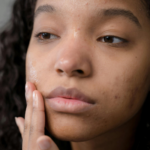A scar is the body’s natural response to healing after an injury, like a cut, burn, or surgical incision. When the deeper layer of the skin, the dermis, is damaged, the body forms new collagen fibers to mend the damage, resulting in a scar. The texture, color, and size of the scar varies depending on its location and each individual’s healing process. While most scars fade over time, some become more prominent, affecting the skin’s texture and appearance. Here’s information on scar revision procedures and how they reduce the appearance of scars:
What Is a Scar Revision Procedure?
A scar revision is a cosmetic procedure performed to improve the appearance of a scar. Revisions do not completely erase scars, as they cannot be entirely removed, but can make them less noticeable. By altering the scar’s size, shape, or color, revision procedures help it blend in with the surrounding skin texture. This process is beneficial for individuals who wish to alter the appearance of a scar or for those who experience physical discomfort due to their scars.
The benefits of scar revision extend beyond aesthetic improvement. Procedures can help reduce itching, tightness, and pain from certain types of scars and help restore function to a part of the body that may be limited by scar tissue. Some common causes of scarring include:
- Surgical Incisions
- Accidents or Injuries
- Certain Skin Conditions
- Burns
- Acne
What Are the Different Types of Scars?
Scars can present in various forms, and understanding the type of scar is key for determining the appropriate approach for a revision. Two common types of raised scars are hypertrophic scars and keloid scars. While they may appear similar, they have distinct characteristics.
Hypertrophic Scar
A hypertrophic scar is a thick, raised scar that stays within the boundaries of the original wound. These scars often appear red and may develop within weeks after the injury. While they can be itchy or uncomfortable, they may improve on their own over the course of a year or more.
Keloid Scar
A keloid scar is a more significant type of raised scar. Keloid scars extend beyond the original injury site, invading the surrounding healthy skin. Keloids continue to grow over time and may not subside without intervention. They may be itchy, tender, or painful and are more common in individuals with darker skin tones. The fundamental difference lies in their growth pattern: hypertrophic scars are confined to the wound area, whereas keloids are not.
When Can You Get a Scar Revision?
Timing is a key factor in the success of a scar revision procedure, becasue a scar must be fully mature before any revision can be done. This maturation process allows the scar to soften, fade, and settle into its final appearance. Most scars take approximately 12 to 18 months to heal and mature completely. Attempting a revision procedure on an immature scar interferes with the natural healing process and may not yield the desired outcome.
During the maturation phase, the appearance of a scar may change significantly. A qualified plastic surgeon can assess your scar to determine if it is ready for treatment. A variety of techniques can be used for scar revision, depending on the type, size, and location of the scar.
Topical treatments, like silicone gels, help improve skin texture and color. Injectable treatments, including corticosteroid injections, may be used to flatten raised scars like keloids and hypertrophic scars. Dermal fillers, microneedling, or laser therapy are some other procedures used for revisions to improve the skin’s texture. For more significant scarring, surgical revision may be an option. This can involve excising the old scar and carefully re-closing the incision to create a less prominent scar or repositioning the scar to make it less conspicuous.
Schedule an Appointment Today
If you have a scar that you would like to have evaluated, consult with a board-certified plastic surgeon for more information. A professional can assess your scar, discuss your goals, and recommend an appropriate course of action to improve its appearance. Schedule an appointment to start your personalized treatments.



